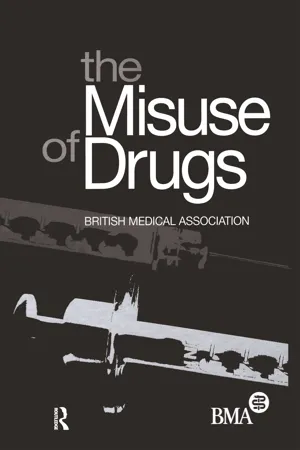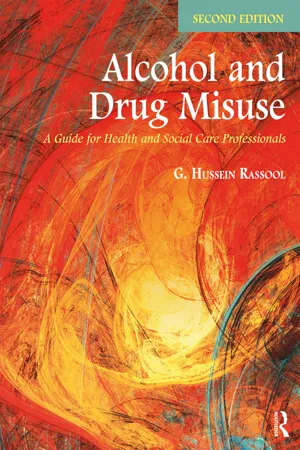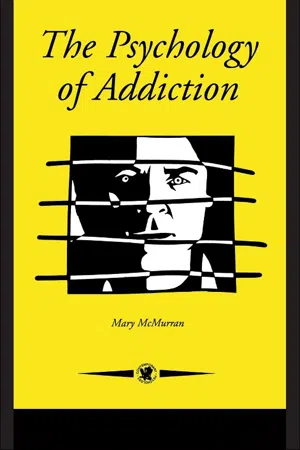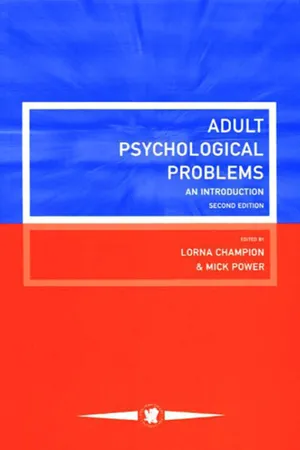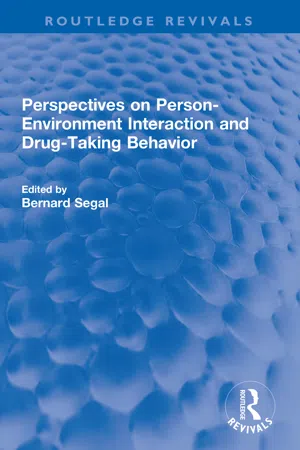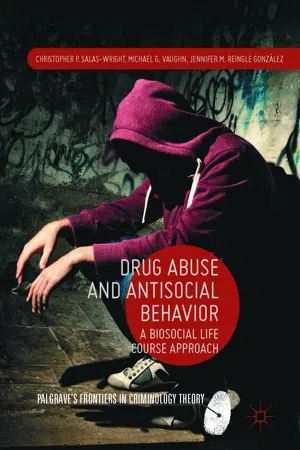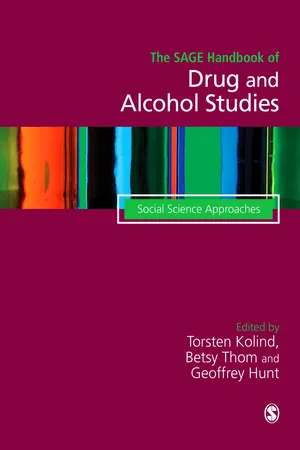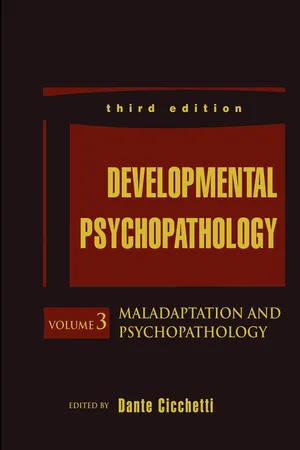Psychology
Psychological Influences on Drug Use
Psychological influences on drug use refer to the various mental and emotional factors that can contribute to an individual's decision to use drugs. These influences may include stress, peer pressure, mental health disorders, and personality traits. Understanding these psychological factors is crucial for developing effective prevention and intervention strategies for drug abuse.
Written by Perlego with AI-assistance
Related key terms
Related key terms
1 of 4
Related key terms
1 of 3
12 Key excerpts on "Psychological Influences on Drug Use"
- eBook - ePub
- British Medical Association(Author)
- 2022(Publication Date)
- Routledge(Publisher)
2 Defining the problem DOI: 10.4324/9781003211136-3Concepts and definitions
The use of drugs (including alcohol and tobacco) for non-medical purposes is a little understood aspect of human behaviour. The most extensive and solid scientific work on drugs relates to their chemical composidon and effects on laboratory animals. We also know something about the characteristics of people whose use of drugs has caused them medical, social or legal problems (they are the users most likely to come to the attention of doctors, drug services or the police). However, information derived from these sources does not particularly contribute to our understanding of drug use, nor how social and psychological processes can influence the outcome of drug-taking behaviour.The psychological and physiological effects of drug-taking are most strongly influenced by the amount taken and the chemical make-up of the drug, and secondly whether the drug is new to the individual, what the user wants and expects to happen (their ‘set’), the surroundings in which it is taken (the ‘setting’), and the reactions of other people.1 All these influences are themselves tied up with social and cultural beliefs about drugs, as well as the individual drug user’s psychological profile and more general social conditions. The same person will react differently at different times. It is therefore often misleading to make simple cause and effect statements about drugs, such as ‘drug X always causes condition Y’.Drug terminology
Although throughout this report we will refer to ‘drug misuse’, some people prefer to use the terms ‘drug use’ or ‘drug abuse’. Theoretically, the 3 terms may be used to indicate a spectrum of harm which an individual may be doing to themselves: ‘use’ being fairly controlled, ‘misuse’ being less so encompassing use that is harmful, dependent or use of substances as part of a wider spectrum of problematic or harmful behaviour2 - eBook - ePub
Alcohol and Drug Misuse
A Guide for Health and Social Care Professionals
- G. Hussein Rassool(Author)
- 2017(Publication Date)
- Routledge(Publisher)
et al. 2008; Otter and Martin 1996). There are significant differences on the effect of drugs between those with introvert and extrovert personalities. There is evidence to suggest that the same dose of a sedative can affect more than 95% of extroverts, while less than 10% of introverts (Gossop 2013). The psychological state of the drug user is very important as this has a significant influence on the effects and dangers of drug use (and alcohol). For example, drug users that have low mood or are anxious or depressed are more liable to have disturbing experiences when using psychoactive substances. Their psychological state may be more pronounced and their likelihood of becoming more anxious, disorientated and potentially aggressive may increase. Individuals with psychological disorders such as anorexia nervosa or bulimia can also deteriorate as a result of the use of psychoactive substances. Health problems such as cardiovascular disease, hypertension, asthma, epilepsy, diabetes mellitus or liver disease can exacerbate the use of psychoactive substances and make them more unsafe.In addition, the knowledge, attitude and expectations (psychological set) about a drug will have an influence on the “drug experience”. For example, if an individual believes or expects, as a self-fulfilling prophecy, that a particular substance will produce a certain effect, the desired effect may be experienced. There is a need to look beyond the immediate intoxicating effects of drugs, and consider drug taking within the wider social context.The last set of factors is the setting or context in which a drug is used. This includes the physical environment where the drug is used, the cultural influences of the community where the drug is consumed, the laws related to drug use and the context in which a drug is used.All three of the interrelated factors, pharmacological properties, individual differences and context of use influence the individual experiences of drug taking. It is stated thatit is necessary to see the drug-brain interaction not as a simple chemical event but as a matter of considerable complexity involving the drug, the particular person, and the messages and teachings which come from the environment and which powerfully influence the nature and meaning of the drug experience.(Royal College of Psychiatrists 1987)The alcohol experience
Alcohol plays a big role in the lives of people globally. Most young people are “socialised” into alcohol drinking in households where their parents drink alcohol and where alcohol is accessible. In addition, establishments including public bars, clubs and private parties where recreational alcohol drinking is the primary activity may provide opportunities for young people to be initiated into the drinking culture and getting drunk. The first experience of alcohol for young people depends on several factors including: parental use of alcohol; parents’ attitudes to alcohol; as a child, parental allowance of small sips of drinks on special occasions; being introduced to alcopop (taste very similar to soft drinks with relatively low alcohol content); religious values; birthday parties and the offering of alcohol from their peers to “look cool”. - eBook - ePub
- Mary McMurran(Author)
- 2003(Publication Date)
- Routledge(Publisher)
Chapter 2 Psychological Approaches to AddictionPsychologists view behaviour—all kinds of behaviour and not just addictions—as determined by a multitude of factors. A list of factors that needs to be taken into account in explaining behaviour is presented Table 2.1. Our understanding of behaviour is not fixed upon any one factor, but acknowledges this range of influences operating simultaneously. Looking at this list, it should be quite obvious that the influences that determine behaviour will vary from one person to the next, and will vary for any one person over time. The influence of these broad factors can be readily illustrated in relation to substance use.Table 2.1 Factors that determine behaviourDifferences exist both between cultural groups and within any one cultural group across time in their laws and attitudes to drinking and drug use. We saw in the previous chapter how legislation to control alcohol and drug use developed over time in Britain and the US, and how alcohol was prohibited in the US between 1919 and 1933. Today, drinking alcohol is permitted in most western countries, yet it is prohibited in some countries, for example Saudi Arabia. We need look no further than the Netherlands for an example of a country today where the use of cannabis is not a criminal offence. A country’s legal position in relation to substance use can influence an individual’s consumption by affecting availability, restricting the opportunities for using a substance, and conveying cultural attitudes to substance use. Restrictions do not always take effect in the desired direction, however; for some people, the excitement and risk attached to illicit drug use may actually attract them toward this activity. Indeed, part of the reasoning behind the decriminalization of cannabis in the Netherlands was to make drug use boring, and this appears to have been achieved successfully since consumption there has declined since the 1970s (Nadelman, 1989). Various groups within society also arrange to convey messages about drinking and drug use, for example the annual ‘Drinkwise’ day and the ‘Just Say No’ campaign organized by health educators. The general point here is that cultural factors can influence a person’s drinking and drug use in a number of ways. - eBook - ePub
- Sandy Jackson, Luc Goossens, Sandy Jackson, Luc Goossens(Authors)
- 2020(Publication Date)
- Psychology Press(Publisher)
Finally, another interesting proposal is the model by Hawkins, Catalino and Miller (1992). This model is based on the assumption that the different risk factors that configure the biopsychosocial matrix do not occur independently or in isolation but frequently take place in combination, thus affecting different areas of the adolescent’s performance. Adolescents susceptible to highrisk behaviours show problems in multiple areas and tend to belong to social networks that foster the development of these risk behaviours and reinforce their continued performance (Hawkins et al., 2002). These authors consider it necessary to study the different risk factors that are present in substance consumption from an ecological perspective, which takes into account five basic contexts: individuals, school, family, peers, and community. In this respect, they consider laws and normative behaviours, availability of substances, economic deprivation, neighbourhood disorganization and mobility to be important risk factors for substance consumption in the societycommunity context. In the family context, organization, practices of family control, conflicts, and parental styles are also considered to be relevant risk factors. In the academic area, some significant factors are recurrent absenteeism, low academic performance, little connection with the school environment and the existence of persistent and early antisocial behaviours. In relation to the peer group, Hawkins et al. (1992, 2002) regard peer rejection (or indifference at elementary school), favourable attitudes to substance consumption as well as behaviours of substance use by peers to be facilitator factors of drug consumption. Finally, in an individual context, biological and cognitive factors, rebellion against normative attitudes and values of society, lack of coping abilities, and a precocious initiation in deviant behaviours are considered by these authors to be important predictors of substance consumption.4. Applying constructs from the biopsychosocial model to initiation and continued drug useIn accordance with the main contexts (individual, family, peer group and community) proposed in the biopsychological theories just mentioned, we will now try to integrate the different concepts and constructs on which these approaches are based in an explicative model that is focused on the risk factors associated to the different phases of drug consumption.As is shown in more detail in the following, while a considerable number of these risk factors concern the individual at different levels (biological, psychological, and socio-demographical), some refer to the influences of significant others (family and peers), and some refer to elements of a macro social order.4.1 The individual: Biological psychological, and structural variables 4.1.1 Biological variablesThe studies carried out in this field have shown that various drugs that produce an increase in a positive mood or euphoria, such as nicotine and alcohol, directly or indirectly affect the inhibiting neurotransmitter GABA, dopamine in the accubems nucleus or in the prefrontal cortex (Hodgkins et al., 2004; Tomkins & Sellers, 2001). The stimulation of these dopaminergic mechanisms represents the most important factor in explaining the strengthening effects and the potential addiction of various abusive substances. In addition to dopamine, it has been confirmed that certain proteins and other neurotransmitters contribute to the pathophysiology of the individual risk of drug dependency (Smith & Capps, 2005). - eBook - ePub
Adult Psychological Problems
An Introduction
- Lorna Champion, Michael Power(Authors)
- 2014(Publication Date)
- Taylor & Francis(Publisher)
There have been numerous hypotheses regarding the underlying causes of psychological dependence, with varying implications for treatment. On the one hand it has often been suggested that certain personality traits may be associated with proneness to addiction; as yet there is little convincing evidence that this is so. Other theories focus on particular drug effects that the individual experiences, and conceptualise psychological dependence as an inability to cope with the void that cessation of drug use would leave. Whereas psychoanalytic models may postulate that the drug serves crucial symbolic functions, cognitive-behavioural formulations emphasise very practical needs such as dealing with stress, or acceptance within a particular sub-culture. This theoretical framework will be discussed at greater length later.As it has been recognised that addiction to drugs is largely a psychological phenomenon, parallels have been drawn with other types of compulsive behaviour such as gambling or over-eating, and it is now common to hear the term “addiction” applied to these behavioural abnormalities; similarly, the word “workaholism” has been coined to describe what is perceived as pathological over-working. This terminology assumes that these superficially diverse behaviours are maladaptive responses to a range of underlying needs, excessive drug use representing just one example of such a general process.APPROACHES TO UNDERSTANDING AND TREATING ADDICTION
As is clear from the foregoing discussion, addiction is a complex and multifaceted disorder, and interventions are correspondingly diverse. Although a proportion of addicts either quit unaided, or seek help to do so because, for one reason or another, they have come to see their dependence as undesirable in itself, there is a substantial proportion who would prefer to carry on using drugs and do not consider drug use per se - Bernard Segal(Author)
- 2022(Publication Date)
- Routledge(Publisher)
Rounsaville, Spitzer & Williams, 1986 ). Alexander and Hadaway (1982) advance a similar argument with regard to opiate addiction, that repeated mere exposure to the chemical is not a sufficient condition to explain addictive behaviour, and we must look to drug use as adaptive behaviour.The role of pharmacological effects is still problematical. Consider the relationship between stress and drug use, and the proposition that people may use substances to cope with stress (see Shiffman & Wills [Eds.], 1985). Such a proposition actually should be decomposed into several specific hypotheses: (1) drugs provide pharmacological effects which enable the person to cope with stress, either by reducing feelings of tension or by substituting an intensely pleasurable experience, (2) tension-reducing or hedonic/distracting drug effects reinforce further drug use, perhaps to the extent of an overlearned habit or “addiction,” (3) after repeatedly experiencing such effects, drug users develop expectancies, that drinking or other drug use helps one to relax when under stress, and (4) expectancies regarding positive drug effects lead to the use of that drug in certain situations. All of these are defensible propositions—to a degree.However, the extensive research literature shows the picture to be considerably more complicated. Alcohol (or other drugs) may or may not reduce tension, dependent upon dose level, set and setting (Cappell & Greeley, 1987 ). Many drug effects arc biphasic, perhaps by eliciting a compensatory reaction (Siegel, 1979 ), or simply as a function of time and whether blood concentrations are ascending or descending. Thus, it is difficult to isolate certain effects as reinforcing. While expectancies about a drug may derive in part from direct experience with the drug, they also clearly reflect cultural expectations which are learned through interactions with others. For example, recognition and definition of a set of physiological and psychological symptoms as a marijuana “high” occur within a group setting where interpretations are shared (Becker, 1967 ). The notions of alcohol as a “disinhibitor” is widely shared in our culture, portrayed in mass media, and surely influences our expectancies regarding alcohol (Mac-Andrew & Egerton, 1969). Expectancies or “set” profoundly influence the effects of any psychoactive drug. Indeed, research using “balanced placebo designs” shows the primacy of expectancy over pharmacology in regard to many alcohol effects (Marlatt & Rohsenow, 1980- eBook - ePub
Drug Abuse and Antisocial Behavior
A Biosocial Life Course Approach
- Christopher P. Salas-Wright, Michael G. Vaughn, Jennifer M. Reingle González(Authors)
- 2017(Publication Date)
- Palgrave Macmillan(Publisher)
2014 ). The list goes on and on as we have observed the manifold ways that social factors of all sorts help us make sense of who is and isn’t at heightened risk of addiction. Beyond the specifics, the takeaway here is that, while neurobiology is indispensable to a state-of-the-art understanding of addiction, there is simply no getting around the fact that drug abuse and addiction are phenomena that are also profoundly social in nature.Above we mentioned that some thinkers would likely suggest we situate our understanding of addicted brains within a broader social context. We should note that such thinking is not unique to ecological-systems theorists, but rather is an assertion that is also made by the leading proponents of the brain disease model of addiction. Leshner (1997 ) notes quite clearly in his seminal piece on addiction as a brain disease that “Addiction is not just a brain disease. It is a brain disease for which the social contexts in which it has both developed and is expressed are critically important” (p. 46). Similarly, McLellan et al. (2000 ), in their original article casting addiction as a chronic medical illness, unequivocally underscore the critical importance of factors such as socioeconomic status and social supports in the successful treatment of addiction and other chronic illnesses. Along the same lines, even a cursory review of the neurobiological model proposed by Volkow and Baler (2014 ) points to the foundational impact of factors in the economic, social, and built environment in influencing risk for drug use disorders. Simply, since its inception, leading theorists have continually recognized that the genetic and neurobiological understanding of addiction must be situated within a social, economic, and environmental context. In the words of Carter and Hall (2012 ),A major challenge for addiction policy and ethics will be finding ways to educate the public about the neurobiological basis of addiction in ways that recognize that drug use and addiction involves changes in the brain, but can still nevertheless be affected by individual and social choices, and the social environment (p. 249). - eBook - ePub
- Bernard Segal(Author)
- 2014(Publication Date)
- Routledge(Publisher)
Perspectives on Drug Use in the United States Louise G. Richards, Ph.D.ABSTRACT. Different views have prevailed within our society that have provided divergent approaches to explain drug use and drug addiction. Many of these approaches have involved medical, sociological and psychological perspectives; moral factors have also been evoked. This paper explores drug use from a different perspective—cultural anthropology. It discusses drug use as a natural result of human technology. Drawing on a theory of culture as communication systems derived from elaborate patterns of behavior, this paper proposes that criminal and medical explanations of drug abuse have inhibited the development of a comprehensive understanding of drug use. It is possible that a “new culture” has developed in which many people anticipate using some type of psychoactive substance, selected from the legal, illicit and prescribed substances, on an “as needed” basis to change mood or feeling-state. These thoughts are elaborated on in the present article.Drug use and addiction have existed under several different guiding policy assumptions: disregarded as personal eccentricity; labelled as a scourge on the society, especially the criminality and violence attributed to use; believed to be a disease that can be treated and perhaps cured. This paper will explore another conceptualization that may throw additional light on what seems to be an intractable problem. It is a framework derived from cultural anthropology: psychoactive substances as the natural result of human technology, their consumption patterns, and their spread through the population. Drawing on a theory of culture as communication systems derived from elaborate patterns of behavior (Hall, 1959), it is proposed that the criminal and medical conceptualizations have kept us in a defensive posture toward drug use. Consideration of abused drugs and others substances as part of the exploitation system of the society leads to new insights into the phenomenon. It is possible that a new “implicit culture” has developed in which a large share of the population expects to use some psychoactive substance, selected from among the legal, illicit and prescribed ones, on an “as needed” basis, to change mood or feeling-state. These thoughts are developed further in the sections that follow. - eBook - ePub
The SAGE Handbook of Drug & Alcohol Studies
Social Science Approaches
- Torsten Kolind, Betsy Thom, Geoffrey Hunt, Torsten Kolind, Betsy Thom, Geoffrey Hunt(Authors)
- 2016(Publication Date)
- SAGE Publications Ltd(Publisher)
4 Psychological Explanations of AddictionRobert Hill and Jennifer HarrisIntroduction
Terms such as ‘addiction’, ‘dependence’ and ‘excessive appetites’ are used to describe an individual’s overwhelming, intense desire to engage in a particular behaviour, despite the negative consequences of doing so. Addiction is typically thought of as relating to psychoactive substances but encompasses other behaviours that can become compulsive such as eating, gambling, sexual activity, exercising and shopping. While these behaviours are thought to share similar psychological processes, psychoactive substances exert an additional unique neurobiological impact on the brain, psyche and body. With repeated use, the body and mind can adapt to the substance so that, if prevented from taking the substance, they can enter a withdrawal state. This triggers the urge to use in order to gain relief and regain equilibrium. Tolerance develops so that the individual experiences the need for increasingly frequent doses of the substance to maintain biological, neurological and psychological homeostasis. Alongside the typical cycle of craving, substance-seeking and use, relief and withdrawal, there is a concomitant narrowing of interests, social contact and lifestyle in order to focus on the substance. It may seem perplexing that the behaviour continues despite the dwindling positive effects of substance use over time, together with the considerable negative impact on physical and mental health, social, financial and legal aspects of life. Moreover, substance dependence has historically been viewed in terms of a chronic relapsing condition with periods of remission and relapse. The two major psychiatric diagnostic systems, the World Health Organisation's International Classification of Mental and Behavioural Disorders (ICD-10; WHO, 1992) and the American Diagnostic and Statistical Manual of Mental Disorders, Version 5 (DSM-5; APA, 2014), clearly describe the above physiological, behavioural, cognitive and social features of excessive and dependent substance use. - eBook - ePub
- David M. Warburton(Author)
- 2023(Publication Date)
- CRC Press(Publisher)
10DRUG ADDICTION AS A PSYCHOBIOLOGICAL PROCESSMichael A. Bozarth DOI: 10.4324/9781003420170-10INTRODUCTION
This chapter addresses the etiology of drug “addiction”. The emphasis is on biological mechanisms underlying “addiction”, although some other factors influencing drug use will also be discussed. The presentation is limited primarily to psychomotor stimulants (e.g. amphetamine, cocaine) and opiates (e.g. heroin, morphine) for two reasons. First, considerable knowledge has been gained during the past 15 years regarding the neurobiological mechanisms mediating their use. Second, these two pharmacological classes represent the best examples of potent addictive drugs, and the elucidation of their “addiction potential” can provide a framework for understanding use and abuse to other psychotropic agents.Some psychologists and sociologists assert that animal studies do not model the important psychological variables governing drug use. They suggest that psychological processes critical in the etiology of use cannot be studied in animal models and/or that environmental influences important in producing use cannot be duplicated in animal studies. This position is generally untenable, and animal models have been developed that accurately represent the primary processes involved in drug “addiction”. Support for the validity of these animal models will emanate from an understanding of the characteristics and the neural basis of drug use summarized in the following sections. The arguments presented in the chapter are tenable, but they represent only one of several perspectives used in studying substance use. The terminology and even some aspects of the empirical data are the topics of scientific debate. The objective of this chapter is not to provide a balanced presentation of controversial issues, but rather to develop a unifying framework for understanding the psychobiological basis of “addiction”. - eBook - ePub
Deviance and Crime
Theory, Research and Policy
- Walter DeKeseredy, Desmond Ellis, Shahid Alvi(Authors)
- 2014(Publication Date)
- Routledge(Publisher)
In sum, feminist studies on women’s use of drugs have built a persuasive body of evidence indicating that their pathways, experiences, and exit strategies are different than those of men, and that these processes are deeply rooted in broader problems of sexism and patriarchy in modern societies, as well as class and race issues. As this evidence builds, it is critically important for policymakers, healthcare workers, and other practitioners to take women’s different experiences seriously.Summary
In this chapter we have examined empirical and theoretical aspects of drug use and abuse. After reading it, you should understand why it is important to use subjectivist definitions of “drugs.” In addition, we presented an overview of the levels of drug use in the United States, the kinds of drugs people use, and the characteristics of drugs and the people who use them. As we have noted in other chapters in this book, none of the theoretical explanations offered in this chapter are by themselves capable of explaining the multiple realities of drug use and abuse. Indeed, because this book focuses on the sociology of deviant and criminal behavior, we have not explored emerging research emphasizing the biological and psychological correlates of addiction, and how these are related to social settings and relationships.The theories explored here, however, do point to the centrality of social conditions such as poverty, deprivation, and gender relations in explaining drug use and abuse. Moreover, the chapter has attempted to show that the current drug war in America has not worked, and that the time to consider alternative strategies—perhaps one of “reducing the harm” caused by drug abuse—is long overdue. - Dante Cicchetti, Dante Cicchetti(Authors)
- 2016(Publication Date)
- Wiley(Publisher)
However, the impulsive processes that are specifically associated with drug use (as opposed to reward seeking more generally) are thought to represent key, distinctive features of substance dependence and could map onto neuroadaptive processes such as incentive sensitization and allostasis (Berridge & Robinson, 2006). This is not to say that substance use doesn't affect the reflective system; clearly it could, either through neurotoxic effects on prefrontal brain structures subserving executive functions (e.g., Lyvers, 2000) or because the constant burden of attempting to control excessive impulsive processes can, at least temporarily, wear down self-control (Muraven & Baumeister, 2000). However, it can be argued that the impulsive system conceptually converges with what might be considered the “core” of addiction (Sher, Wolf, & Martinez, 2009). That is, if we can assess impulsive processes, we can assess processes that appear to be distinctly and directly associated with the motivational salience of drugs that, in turn, is intimately related to the neurobiological theories of addiction. Behavioral Assessment of Impulsive Processes: Implicit Cognition To date, researchers have employed a number of tasks designed to assess the degree to which cues associated with drugs are capable of engaging impulsive processes. Most of these are considered implicit measures as distinct from explicit measures (such as the drug use motivation questionnaires referred to earlier). There are a number of different definitions as to what constitutes an implicit measure although, as a group, they tend to have certain characteristics in common, to varying degrees. According to De Houwer (2006), these include (1) the individual being assessed is unaware of what they are being assessed for; (2) the individual does not have conscious access to the cognition that is being assessed; and (3) the individual has limited control over the outcome being assessed. As described by Wiers et al
Index pages curate the most relevant extracts from our library of academic textbooks. They’ve been created using an in-house natural language model (NLM), each adding context and meaning to key research topics.
Explore more topic indexes
Explore more topic indexes
1 of 6
Explore more topic indexes
1 of 4
